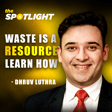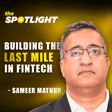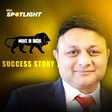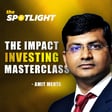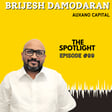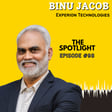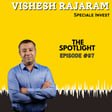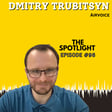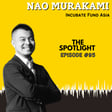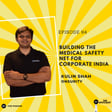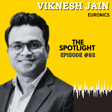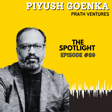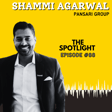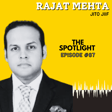Become a Creator today!Start creating today - Share your story with the world!
Start for free
00:00:00
00:00:01

Powering the tech stack of fintechs | Rajat Deshpande @ FinBox
FinBox has built the pipes that help fintech companies ingest user data, apply decision-making engines and run their workflows through an orchestration engine. Rajat discusses building pipes for the fintech space and creating a global business.
Transcript
Introduction to Finbox and Its Role in Fintech Infrastructure
00:00:00
Speaker
I am the co-founder and CEO of Inbox, a fintech infrastructure company based out of India.
00:00:22
Speaker
You've surely heard the saying that the best way to make money in a gold rush is by selling shovels. And in the current fintech gold rush, Finbox is the company that is selling shovels. Finbox has built the pipes that help fintech companies to ingest user data, apply decision-making engines and run their workflows through an orchestration engine. In this episode, your host Akshay Dutt interviews Rajat Deshpande, the founder of Finbox, about the business of making pipes for the fintech space and creating a global business out of that.
Services and Technology Offered by Finbox
00:00:51
Speaker
Stay tuned and subscribe to the Founder Thesis Podcast on any audio streaming platform to learn about building niche global technology businesses. Let's start first with an elevator pitch of Finbox. If you were pitching to me to raise funds, what would be your elevator pitch for Finbox?
00:01:18
Speaker
Finbox essentially is a company that is building FinTech infrastructure and credit intelligence APIs. So we're basically lending focused APIs that enable, you know, companies to build digital credit products. So these products could be buy now, pay later, personal loans, business loans, a B2B buy now, pay later, working capital loans, et cetera.
00:01:43
Speaker
And we provide end-to-end from sort of KYC credit decisioning to dispersal integration with a bunch of lending partners. And on the other side, we have credit intelligence products. Okay, interesting. So just to make it a little simpler, what part of your business is fetching data?
00:02:03
Speaker
where you fetch data, it could be the adhar, pan, etc. or it could be the account information about the person. And this data is used to eventually arrive at a credit decision that should I lend or not. And the second part of your business is the decision making engine or the recommendation engine, which would throw up scores based on data, which would help a lender to decide whether to lend, how much to lend, etc.
00:02:29
Speaker
No, so this is the first business. So basically getting sort of using various kinds of data sources for decisions and there are different. So this is, you could say, credit intelligence business, which includes fraud, you know, credit, risk, all of the other analytics, various data sources.
00:02:48
Speaker
Second business is an end-to-end infrastructure piece. So basically say you are like an e-commerce player, and you want to now start offering your own white-labeled, buy-now-pay-later program. So you come to us, and you integrate our API and SDK, and you configure the product. And that's it. You are done, and you can get started with the program in, say, about two, three weeks.
00:03:14
Speaker
We bring the lender partners and sort of help you construct the program. It's like a plug and play digital lending product. Any company can launch a digital lending product through a plug and play solution that you offer. Yeah. So that's one part and then lenders also use it
Finbox's Position as a Neutral Technology Provider
00:03:33
Speaker
essentially. And the largest chunk of business today comes from our lending partners.
00:03:37
Speaker
So one of your business lines is competing with Niro. Niro is in a similar space where they allow, let's say an e-commerce company wants to launch a BNPL or any such product. They can do that through Niro. So something similar is... Niro maybe sources these loans, but they also aggregate essentially. So basically what aggregation means in e-commerce is that you get inventory and then you take a margin, you sell inventory.
00:04:06
Speaker
So that's one thing. What we do essentially is we are a very neutral technology player. So what we do is what Shopify does. We are like, OK, take this tech. You talk to each other. Build your sort of, you know, you decide the commercials. We don't care about it. We will help you get to that. But we are not in the business of really aggregating you or you. We are just the pipe.
00:04:29
Speaker
which is enabling this business to happen. And so we are a technology business, a TSP business as it's called in India today. So there's an aggregation business, which is the LSP business, quote unquote, sort of a little fuzzy. What are the full forms? LSP is a loan service provider, basically. And TSP is a technology service provider. So we're not really an LSP, we are a TSP.
00:04:58
Speaker
So what you're saying is that Nero already has relationships with lending partners and commercials, whatever the negotiations are already done. Yeah, absolutely. So Nero could be our customer also in
Revenue Models and Market Strategy
00:05:11
Speaker
a way, right? Because ultimately we don't really care about or sort of try to aggregate these people and sort of in my understanding, maybe Nero does sort of take a little bit of credit risk, etc.
00:05:26
Speaker
you know, those things we don't know. We are a pure technology business and generally stand neutral in these sort of, you know, business models. So you work with everyone. So Nero also potentially we could work with.
00:05:40
Speaker
So these three products, one product is information and decision making like capturing data and then reaching to a decision based on that. The second product is helping like say a consumer, a B2C internet company to start offering lending. And the third product is helping a lending company to offer an online product. But the second one or two categories is the same product is just, you know, who's using it.
00:06:06
Speaker
What is your customer profile like? What business do you get from lending companies as a percentage of the pie? And what business comes from a B2C internet company which is offering lending? I think most of our revenue does come from lending companies. There may be about 50% is from lending companies, 30% would be from what we call as anchor partners. And I think that mix is going to remain because of course, you know, lending companies
00:06:35
Speaker
they really have large balance sheets and they have a high risk appetite and they sort of, you know, move very fast with this. This is like not a side activity for them. It's their core business and that becomes large, very fast. And as we keep adding more and more lender partners, you know, the lending sort of from the lender comes from banks and NVFCs is that much, much, much more higher volumes than maybe a little bit of these two C folks.
00:07:04
Speaker
Because for a lender, this is a core part of their business whereas for a B2C internet company, this is an ancillary revenue. Yeah, it's an ancillary revenue and we do a bunch on very large anchor partners, we do a bunch frankly.
00:07:21
Speaker
Who are some of these anchor partners? You can describe them. Large Super Apps, Conglomerate, Super Apps, etc. A bunch of those. Large B2B commerce platforms. B2B like Odaan types. Yeah, I agree. And then sort of more, you know, B2B marketplaces for goods. I think we were one of the first guys sort of in India at least who published a blog saying embedded finance.
00:07:47
Speaker
XYZ, Hoga. And we realized it fairly, I would say, during the first wave of afterward and we built a product which was integratable, etc. Your anchor partner customers are essentially customers for whom they would feel that there is a lot of promise in starting lending, which is why they would want to invest in building those relationships directly with the NBFC partners and then using your stack to enable that.
00:08:15
Speaker
Yeah, absolutely. Lending does a bunch of stuff on platforms and different platforms have different motivations. For example, some folks do it for monetization.
00:08:28
Speaker
That's the best way to monetize sometimes. So these companies would earn a spread or would they earn like a referral fees, like every loan that? Both models exist, both models exist. Mostly, I would say it is referral based, but in certain cases it's spread based as well. So you were saying why these platforms want to offer lending? So one is modernization, another is essentially
00:08:52
Speaker
more retention, you know, better user experience or sort of completeness of product, right? So good product experiences, et cetera. Third is, you know, basically, for example, in e-commerce or B2B e-commerce, it leads to higher, you know, average ticket size or ACV, basically average card size, et cetera, increases by 30, 40%.
00:09:15
Speaker
And we've done like a fairly deep dive on the numbers here and it does meaningfully change the dynamics of these businesses. Okay, interesting. What are some numbers that you track? Is it like number of loans originated or is it your ARR? So there's a bunch that we track. I think, see, because they're separate businesses and we are a TSP business, we basically track
00:09:40
Speaker
API calls. Your revenue is purely on API calls. So dispersal are correlated of course with API calls. And what is your ARR currently? What kind of growth trend have you seen? We've grown about 120% over the past year and so pretty much doubled. We are in this sort of high single digits of a million dollars of hype now.
00:10:07
Speaker
and we hope to double again over the next year or so.
Rajat Deshpande's Journey to Fintech Entrepreneurship
00:10:11
Speaker
When do you think you'll cross 10 million dollars? Hopefully within the next year. Tell me about the journey of how you reached here. I believe you passed out from IT Bombay in 2009 and you started this about eight years after passing out. So just a summary of what you did in those eight years, what led to the birth of this.
00:10:33
Speaker
It's an interesting story. One is, you know, I started my career after, of course, 2009 was the great financial crisis here. So I started mostly in pharmaceutical consulting with the ZS associates, then I moved to Citigroup as a quant, work with the trading desks in New York, and then a little bit in UK on structured finance, and then
00:11:00
Speaker
Sort of I quit 2014, joined healthcard.com as a product manager focused on mobile. And basically in 2015, we had an idea of building a personal finance management app using, you know, phone data. And it was a consumer business. We started it in Gurgaon for about
00:11:25
Speaker
half a year-ish and then we realized that we were not cut out for consumer and also I personally realized that I needed like somebody to guide me or an ecosystem of people that we could learn from in terms of the startup you know stuff that we wanted to do. Did you raise funds or like when you launched this? We were like a very very razor sharp on building revenues even with a consumer startup we were like what can we sell etc right and
00:11:54
Speaker
You know, those days I would say it wasn't easy to monetize in consumer, you know, and I think our mental model was also wrong. But yeah, we did pitch to a bunch of VCs and nobody really understood us. It was interesting, frankly. Now we see maybe what it takes to build a consumer company and how it's different from building like a B2B business. And I think realistically, I would say the founder market fit wasn't there.
00:12:25
Speaker
So I'm guessing when we said XYZ stuff to some investors, they didn't really believe us because, you know, we may have the consumer flair or maybe we were just talking, you know, monetization too early or some of those things. And I think nobody wanted to take a, you know,
00:12:43
Speaker
punt on us from a consumer perspective. And I would say rightly so. Then we were like, okay, let's came to Bangalore started on a logistics startup. I became head of product at Gopijan logistics, which was this was a job. Yes. So I came to Bangalore from Gurgaon and then
00:13:05
Speaker
met the folks here saw what the startup vibe was all about and all that and it was like really a new way to live I felt you know because I was like hardcore finance guy jumped into the messy you know domain of really tech startups from healthcare.com but didn't really realize what was happening right and
00:13:25
Speaker
still very, very naive from a startup sort of vantage point. And then I came to Bangalore and really did understand that what it was about, you know, how do I trade on products, et cetera. I knew product management, but from a business context perspective, et cetera.
00:13:42
Speaker
And how do you build a B2B business? So Gopijan was interestingly a B2B business. And we were like, okay, we wanted to sell to companies. They were selling fulfillment or software, like typically logistics. Software. Actually, it was a fantastic business. I really liked it. And, you know, after it got acquired, etc, we were, you know, like, it's just some execution stuff that didn't go right, maybe. But, you know, our competitors then,
00:14:13
Speaker
the smaller guys are now unicorns. So Shiprocket was one of our competitors, like, okay, Shiprocket, et cetera. And they executed brilliantly. And then Shipsea, I think, came later, executed brilliantly. Now very large companies, I would say. And we did realize that there was a problem in the domain, but somehow it didn't really play out really well and it got acquired. But I was, maybe I got like a ringside view into how these things happen, et cetera.
00:14:43
Speaker
And then we, the good part was we met the other two co-founders at Gopishan and like we really hit it off. Sreja Nikhil and one of the co-founders is my brother also, a younger brother Anant. So four of us, we were like, okay, let's do this.
00:15:00
Speaker
You know, that's how it started. We didn't really think of like building a company as I would say we, there used to be in Bangalore, in Domblu, there used to be an access bank thought factory thing. So like a startup incubator and they had like a room outside, which they had just kept so that some starters could one or two days come hang out and do their thing.
00:15:27
Speaker
Basically, we like took over that room. We were like, we could go sit and we just, everybody started to think that that is like Finbox's room. And then one day, Axis Bank folks were like, we want to come in the incubator. So inside part and we're like, yes, of course. And then, you know, we pitched and we did some stuff. We built a weird amount of stuff in the lending domain. In the early days, we tried to build location intelligence. We built a lot of
00:15:56
Speaker
origination stuff, we built a bunch of KYC stuff in the early days, et cetera. And then what click was for us was our data stuff because that is our sort of core work in our sort of earlier lives was with data and building sort of more high performance systems. And that clicked and then we sort of went from to build in deeply the credit intelligence pieces and it's been for them one step in front of the other, I would say.
00:16:26
Speaker
What is the first product which saw traction? Device Connect is the first product. So basically it is an anonymous SDK. So it goes into Android phones and then say it syncs a bunch of data anonymously around the users with consent, I must say, of course.
00:16:47
Speaker
And then we create a bunch of insights. What kind of data? This is data from the Android phone. What kind of apps is the person using some data on anonymous transactional data that is through SMS, et cetera.
00:17:04
Speaker
It could be location data right now. It's sort of become a little more restricted. So mostly, you know, this metadata about the user, and then we generate through machine learning, a bunch of, you know, analytics about income propensity, credit risk, et cetera.
00:17:23
Speaker
and we give it out on APIs. So that was our first product. It became very, very polished, mature, proved itself out during COVID where we could predict a lot of delinquencies, defaults.
00:17:37
Speaker
and then we built a bunch of products on top. So this would be used, like say, if I have an app for loans. Digital lenders, yes, with that. Somebody who's downloading my app, the SDK would be embedded into that and then the lender would get this data and this recommendation through that. Yes, through APIs. While the user is on the loan journey in their app, they can just pull and make a real-time decision.
00:18:06
Speaker
Okay. And who was your first customer lender? Home credit was our first first lender, first large customer, I would say that was like, and then we did have a bunch that really good sort of traction in the early days itself. Home credit is a startup or a traditional lender? It's a multi-country NBFC, which focuses on consumer durables and personal loans.
00:18:34
Speaker
So, it is like a provolander in a way.
00:18:37
Speaker
And how did you get the client? Like who was doing sales? Anand, my younger brother was sort of, he knew the home credit folks. He had worked there for a bit. So he did the sort of closing of the sort of deal. Got it. And which year did you sign on home credit? When was this? I think we did the pilot in 2018, signed on 2019.
Product Development and Adaptation During the Pandemic
00:19:03
Speaker
And then of course, fairly quickly COVID hit, I think 20 by the time we were sort of maybe six months old into what we were doing. So did COVID give you a lot of new business because a lot of lenders who were relying on offline would... The first wave of COVID was a big pain.
00:19:27
Speaker
And then second wave of COVID, I think meaningfully changed the way people were thinking about this. And see, this is an enterprise business. So I think the top of the funnel increased very fast. But of course, the implementation closure takes a bunch of time. But I would say COVID second wave did change people's fundamental ways of thinking about this business. And we have been a beneficiary, net-net.
00:19:53
Speaker
It did also destroy a lot of people's business downstream and because we are a B2B business, if our customers don't make money or if they suffer, then we also suffer. We supported a bunch of our customers through those times.
00:20:11
Speaker
Mind you, we were not a funded business. Meaningfully, we were just bootstrapped for a bunch of times. Profitable, but bootstrapped nevertheless. And it was very hard for us to support our partners. But we did because, of course, that's what you do while building this business.
00:20:35
Speaker
And yeah, but it's played out nicely, I would say, over time. Okay, so this was a first product of the device analytics. What was the next product? The next product is called bank connect, which is essentially bank statement, plus account aggregator software development kit and API. So basically, in the loan journey, you can take data from device make decisions, but then you can also use
00:20:58
Speaker
You need to sometimes take data of bank statements, especially if it's a larger ticket size loan or, you know, it's an MSME loan, et cetera. Once you get it, you have to of course create the entire user experience that is kick-ass, which also combines net banking, the way to sort of upload data or a PDF that we support 500 plus banks.
00:21:20
Speaker
or the account aggregator way. So you need to build a seamless user experience across all three and you have to combine all three data sources seamlessly into one API. So we'll do that. So doesn't account aggregator eliminate the need for PDF upload or the net banking login? You know, our SDK has provided this
00:21:40
Speaker
sort of, you know, ability for the user to choose the mode, they will definitely choose, you know, whatever is the easiest, right? One piece is that account aggregator usage has meaningfully grown. Basic definition of what is account aggregator framework. So account aggregator, it's like open banking in India, and it's an RBI mandated regulated entity called NBFC account aggregator, which facilitates data
Enhancements in Data Integration and User Experience
00:22:08
Speaker
coming from banks through consent.
00:22:11
Speaker
you know, your bank statement data, you can through consent submit to any regulated entity for a specified person first, like taking a loan, later, it could be for health insurance, etc, as well, or it is already being used for say, life insurance and financial underwriting, etc. But essentially, a user can provide consent to any other third party regulated entity to access this data for a specified amount of time. And in a loan journey, this is used to essentially take
00:22:39
Speaker
this data and create analytics to underwrite a borrower.
00:22:46
Speaker
So account aggregator is not the default option that people choose right now. Like I thought that it would be like maybe 90% of the people would be choosing that only because it's so much easier. So see the coverage on account aggregator today is I think, you know, 18 odd banks out of that. I think some of them are a little stable. Most of them are new on the system and it's being stabilized.
00:23:11
Speaker
But on the PDF side, we have 500 banks that are enabled plus, right? So basically, if you imagine, if you look at more urban population, we do think in terms of private sector banks, etc. A lot of bank accounts are in smaller banks, in cooperative banks, etc. Co-operative banks.
00:23:31
Speaker
Okay. So to get data beyond these 18 big banks who have signed up for this account aggregator framework, you need a PDF and what's the net banking thing that you were talking about? Similarly, you know, if, if the borrower doesn't have a PDF or sometimes, you know, right now they want to submit it through their bank account, password and username, then they can submit it by sharing that we, you know, our system is fully encrypted, doesn't store any of these credentials.
00:24:00
Speaker
they provide this consent. We sort of get this data and then that's it. End to end enables. It's like sharing this data. It's like you could say work around for account aggregator. So in India, we do have account aggregator, but say in the US, this is the only way, for example, to get this data. There is no central API integration stuff, I would say. So
00:24:26
Speaker
As account aggregator, it sort of becomes better. I think it's a more consented way and it should become more dominant. And what's the next product? So then from bank connect, there is a bunch here. There is, you know, something which is a multi-bureau connector called Bureau Connect, which is essentially, you know, there are right now four bureaus. And we sort of enable, you know, folks to get this data, harmonize it, enrich it.
00:24:55
Speaker
and sort of provide this on a single API which can again go into the decisioning system. And then there is Sentinel which is a rule engine which sort of consumes all this and you can just sort of devise your policies for this space pricing of loans. So for example, what interest rate should I give?
00:25:13
Speaker
Who should I give two yes or no answers? What should be the tenure, et cetera. It's used by marketplaces for lender ranking. So it's like an end to end system for decisioning. So first is analytics. You have to take this data and sort of make your own decisions. How do you combine it? We don't sort of get involved, but Sentinel is a system which sort of combines everything together. So they would be like a.
00:25:38
Speaker
a scorecard for a borrower. Based on that scorecard, what to offer, that is what Sentinel does. I think at this point, I would say there are three, to make a credit decision, there are broadly two, three steps that you have to follow. One is identify which data sources you are going to get into the system. You have to integrate and get this data. This is, as I said, some of these data sources we provide. These are proprietary connectors.
00:26:06
Speaker
Some of them will be more publicly available. So data. The second is building scorecards or predictors. So basically, what parameters are you going to get from this data? So that's also like deep experience science, et cetera, the expertise that is needed. And then is the rule engine. So you put the scorecard, you put it into the rule engine, and you say things like, OK, if this is coming from an app channel,
00:26:34
Speaker
And, you know, basically in the Finbox, sort of inclusion score is high, then pull bureau data, et cetera. All of this stuff, this orchestration logic is put into Sentinel basically. And you can sort of configure it, do can retesting, A-B testing, all of that.
00:26:52
Speaker
You are confident you just deploy it and then it's done.
Regional Expansion and Brand Building
00:26:56
Speaker
Is it just one single number or is it like on different parameters? No, it's a bunch of parameters depending upon the credit product. What are the scores? So there is something called a Finbox Inclusion score which comes from our device connect product.
00:27:15
Speaker
A good score will imply what? Good score implies low probability of delinquency or defaults. So there's a bunch of different sort of scores and then there could be various criteria on pin codes, it could be based on
00:27:33
Speaker
various channels that this loan is coming through. A bunch of that gets sort of, you know, configured into a rule engine and then you get like an automated decisioning system where the loans are coming and deciding automatically.
00:27:48
Speaker
And I'm guessing that the next product would have been what allows, like say, a nodan to connect with an NVFC and start offering. Yeah. So then, you know, once we've sort of built these pieces, then we are like, okay, let's put all of this together into a cohesive whole and which is the API stack or API platform is for the origination.
00:28:07
Speaker
So basically a platform which is an API-led platform and then it also has a bunch of interfaces and journeys for you to sort of put out and build an origination system into it. So that's the next logical leap that we took. Are you in India or are you like your customers? So we are in India and Southeast Asia, Vietnam and Indonesia now.
00:28:34
Speaker
Because like say the account aggregator framework is there in India, but it will not be there in other countries and all of that. Like what were some of those challenges to solve so that you could go global? I think see financial services is a very, you know, context specific or sort of local context heavy business.
00:28:54
Speaker
So you do have to understand in detail what, how, you know, particular products have run and what are the regulatory environment, sort of considerations of a particular geography. So on all the countries that we've sort of started business, we've sort of.
00:29:11
Speaker
first build connects and understood, you know, the, the local context and then only brought in products that makes sense. Right. So for example, device connect makes sense everywhere where, you know, there are Android devices, we can generate a bunch of analytics, which sort of works across the board. So typically we bring that first to the market where people then can evaluate our, you know, sort of quality of the products that we build.
00:29:36
Speaker
And then as people become more sort of, you know, we've sort of built a little bit of a brand in the geography, then we can bring in sort of more end to end products. That's how we sort of think about it.
Lead Generation and Global Expansion Goals
00:29:49
Speaker
But still, I would say early for us, I would say to learn how to build these businesses outside.
00:29:56
Speaker
What is your go-to market? How do you acquire clients? So we run well-subscribed newsletters. One is I think there's a bunch there.
00:30:07
Speaker
30,000 odd monthly readers on our newsletters and on LinkedIn also. Okay. And these would be like decision makers in FinTech and Lending Domain who would be leading. You know, also, of course, a lot of startup and technology enthusiasts, et cetera. And we built this up over time and, you know, we really wanted to do a great sort of
00:30:31
Speaker
Good job in terms of putting out content. We realized that, you know, great content was a white space, good content was a white space in India. Right. So we wanted to just enjoy building this stuff, this content. We just started with a couple of blog posts and then sort of slowly build this whole newsletter piece.
00:30:50
Speaker
Give me some examples of the things at the newsletter. So this week's newsletter is all about, you know, saying that, okay, can FinTechs keep taking the Jogad route overall towards, you know, building a business. And it sort of goes deep into, you know, what various business models are and how they've sort of shaped up over time, etc.
00:31:11
Speaker
And then there was a bunch on co-lending guidelines and it came out. Then there was a bunch on the entire sort of UPI transaction decline rates and all that. So basically, deep dives on sort of interesting topics that are relevant.
00:31:29
Speaker
and also sort of lending related topics, etc. How did you build the ability to create this content? Did you hire someone from the space? In the very early days, I think we did write a bunch of these blog posts internally. And I think what it did was it set up the overall bar of where we wanted to be.
00:31:54
Speaker
And then, you know, we were, like, very, very fortunate to get a great team doing this. And this is your primary source of lead gen. So this is one that, of course, we've recently started to build a sales team as well. So through Konex, etc. And there's a bunch of blog posts also. So about 150 blog posts, which generates a bunch of traffic on our website. So we get a lot of incoming from there as well.
00:32:22
Speaker
So your global expansion must have been like an organic one where you would have got inquiries from Vietnam and you decided, okay, let's look at this market. Yeah, so we do get a lot of inquiries from all over the world.
00:32:36
Speaker
But I wouldn't say the business that is sort of rectifying at the scale is coming right now, you know, we're not. So I would say because Vietnam needs Vietnamese language blogs more than English, I guess. So I don't think that incoming piece is coming from Southeast Asia, but Europe, Eastern Europe, a lot of it comes from there. UK, a lot of incoming come.
00:33:01
Speaker
But we are not in those markets yet. You did a $15 million fund raise last year. Was it like a walk in the park or was it challenging? Because the first time around when you were trying to raise funds, you were not successful. You realized that maybe there is a founder market misfit happening there.
00:33:22
Speaker
How was it like this time? So eventually we raised total three times over. So we did raise a very small check from this fund called Arali Venture Partners in the early days. 2 crore and then we did a convertible with IFL Finance. They were fairly supportive of what we were doing etc and very gracious in giving us money just before that COVID or I think between the COVID waves at some point.
00:33:50
Speaker
So convertible means the money is given to you as a loan. And it converts in the next round. So the valuation is not decided. Valuation is not decided. The valuation depends on what next round valuation is. But these are very small checks. So they didn't really meaningfully give us enough runway or confidence to really spend big or to really dip into the negative territory. So we were always
00:34:19
Speaker
building with, you know, sort of sustainability in mind. So we were always saying, okay, can we make money to pay payroll and all of the AWS costs, et cetera, that accumulate. Now those things were super interesting that built a bunch of muscles, but we were also like, okay, we are not the kind of business which is going to raise like large money and et cetera. Let's just not focus on that.
00:34:45
Speaker
And in the meantime, we did want to raise money and we were going towards like, we had hired a banker, but I would say the investors found us more than us found the investor. I think we were super lucky to get, you know, the kind of investors we got, I would say very supportive sorted folks who understand business well, you know, and
00:35:12
Speaker
essentially are there when you need them, which is very nice, I would say. And I think we've heard a lot of horror stories with investors, et cetera. I would say our experience has been very, very different. Who led the round? This 15 million round. A91 partners.
00:35:30
Speaker
And Flipkart also invested. Why did Flipkart invest? Was it purely financial or strategic? Yeah, so they have a small fund with financial investment. It's not like they want to start offering BNPL or something using your product like that.
00:35:52
Speaker
No, if that happens, it is going to be a separate conversation. I would say it's not linked to the investment. How big is your organization? It's now 130 people. So tell me about building an organization of 130 people. That's an interesting question. See, we've been super fortunate to have like the earliest guys with us. Right. So now what six year old startup. So we have guys who are six year old with us, right? You guys are five year olds, four year old with us. And I think.
00:36:22
Speaker
You know, we've been able to do that and it's meaningfully and we are super sort of thankful for the guys in believing in us and sort of trusting us. I think one piece is in the early days when say you are up to say a 50, 60 people organization, I think spending a lot of time helping people understand, you know, your ethos, your culture, how do you want to do stuff is very, very important.
00:36:50
Speaker
And I think we are now sort of grown into, you know, a size which is where this approach sort of just spending time generally because we don't like, you know, per unit team member, we have very little time today.
00:37:08
Speaker
So it doesn't really work and I think what we are now trying to do is, you know, magnify this communication maybe through guys who we already have, you know, the sort of more vintage guys with us. They're still young, but they write out of college they came to with us, etc. But they understand this really well and, you know, to sort of help them
00:37:32
Speaker
sort of get to this role where they will be mentoring coaching. That's one. I think we need to improve a lot on how we communicate internally, which is becoming very important. I think to get everybody really aligned, motivated towards the goal.
00:37:48
Speaker
And given if there's a complex business, I think that is something that needs to be done. This communicating internally is an interesting issue. Like, I mean, you know, do you believe more in like, say, a Slack-based approach where there's Slack and everyone is communicating and so people can read and all that? Or is it more like, say, town halls and off-sites and, you know, that kind of approach? What do you think works? We feel both are important, right? Because
00:38:16
Speaker
So if you're sort of sharing ideas, so you need to be able to refer them later. And I think people need to do a lot of written communication. And we have subscribed to a bunch of tools internally, and people do write a lot on notion, et cetera. And I do believe, but it doesn't substitute
00:38:38
Speaker
Town halls, etc. Offsides we do purely for fun though. We don't like big work with offsides that much. But I think, you know, what we want to do essentially going forward is at least have a, we do all of this, but we don't have like a set cadence. I think we will set that up, sort of give people overall understanding of how this works.
00:39:01
Speaker
What's the long-term exit for investors, for the founders? You know, at a personal level, or at least the founders don't think about exit, at least at Finbox. The reason is because, you know, when we've sort of built the business and even now it's a sustainable business, it makes money. And, you know, we are enjoying it tremendously and each phase brings itself a plethora of learning opportunities.
00:39:30
Speaker
So, we don't think about exits as though, you know, we do want to build a very, very interesting and large technology company. And we feel the revenue opportunities are insanely large in this space.
00:39:45
Speaker
And we can build a very, very large business.
Finbox's Vision for the Future
00:39:48
Speaker
So we can build a billion dollar ARR business in this area. Because this area has infinite adjacencies. It's the deepest part of software. So as you can imagine, every software company actually sells to financial services.
00:40:05
Speaker
Any large software company, if you see the largest chunk of revenue comes from financial services and there's a lot to build. A lot of infrastructure is very, very legacy. There's a lot of change and there's a very fast moving market with a lot of opportunity. Every day you will get new opportunities to build something interesting.
00:40:27
Speaker
India scale is so insanely large compared to anybody else in the world, right? That you end up building very, very robust systems, right? And as you build them up and they mature, it is, we feel that the quality of systems as you know, all of the flakiness starts to go away as our startup ecosystem also learns how to build
00:40:49
Speaker
really high quality product. So there is the core, the scalability is there because India is at scale market. The packaging, et cetera, we're getting there. And we feel that in the next couple of years, we can really open up all of the developed markets, et cetera. And the kind of stuff that we have seen, nobody else will see. Basically, each startup works with so many users that are larger than potentially countries, basically.
00:41:18
Speaker
You said there is potential to be like a billion dollar ARR business here. Is there a comparable business in the West in this space?
00:41:28
Speaker
So there are businesses which are at 200 to 300 million dollars of ARR today and they are listed company. And they are in this whole API and data space for lending. Yeah, so that's sort of you could say credit infrastructure space, not if so very few companies globally actually marry these two spaces. People are either technology companies or their data companies. We are like a little bit of
00:41:54
Speaker
both because we are four co-founders and everybody sort of has their own specialization and we drove very hard and passed on both things simultaneously. But a lot of companies sort of either are more technology, they acquire data capabilities or are the opposite.
00:42:12
Speaker
And, but there are companies which have, so there are companies like Blend, there are companies like Encino in the US, which are infrastructure companies and are at a couple of hundred million dollars of ARR and they're growing fast. And they're only in the US in niche segments. So these are like only single product companies from say the home loans, et cetera, or, you know, they're only like very single segment companies. So in the US, they're only at credit unions.
00:42:38
Speaker
Only in the US, these companies will be able to achieve a billion dollars in ARR, I guess, in the next five years. So you can imagine the entire sort of global financial services infrastructure market is very, very large, I would say. Who are your co-operators in the Indian startup ecosystem in this credit infrastructure space?
00:43:00
Speaker
So see, there are a lot of credit infrastructure players, but they are in their own area. So basically credit card infrastructure, et cetera. There's a company called Yap M2P, which started in the credit card infrastructure space. Yeah. Basically I will say, you know, there are, there's M2P that is, who's
00:43:23
Speaker
Actually, there aren't like really direct computers. There is a company called DigiTap? DigiTap on only the data APIs part, right? So as I said, right, we are like, so we've sort of built like a more infrastructure mindset in the company. So we have like APIs for orchestration, etc., not only data.
00:43:45
Speaker
And that brings us to the end of this conversation. I want to ask you for a favor now. Did you like listening to the show? I'd love to hear your feedback about it. Do you have your own startup ideas? I'd love to hear them. Do you have questions for any of the guests that you heard about in the show? I'd love to get your questions and pass them on to the guests. Write to me at adatthepodium.in. That's adatthepodium.in.
